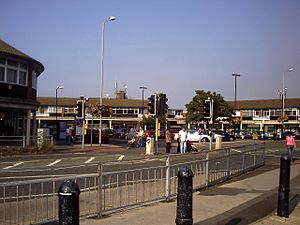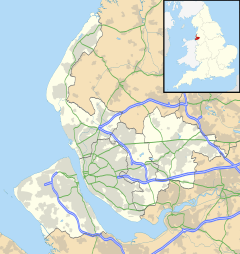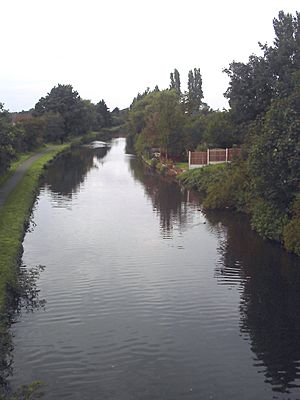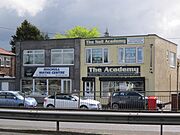Maghull facts for kids
Quick facts for kids Maghull |
|
|---|---|
| Town | |
 Central Square, Maghull |
|
| Population | 20,444 (2011) |
| OS grid reference | SD373027 |
| Civil parish |
|
| Metropolitan borough |
|
| Metropolitan county | |
| Region | |
| Country | England |
| Sovereign state | United Kingdom |
| Post town | LIVERPOOL |
| Postcode district | L31 |
| Dialling code | 0151 |
| Police | Merseyside |
| Fire | Merseyside |
| Ambulance | North West |
| EU Parliament | North West England |
| UK Parliament |
|
Maghull (/məˈɡʌl/ mə-GUL) is a town and civil parish in Sefton, Merseyside, England. A civil parish is a local government area. The town is located north of Liverpool and west of Kirkby. It is also home to Ashworth Hospital.
In 2011, Maghull had a population of 20,444 people. Most of the homes in the town were built in the 20th century. They are mainly semi-detached and detached houses. Maghull has had an elected council since 1894. This was when the government created local councils across England. After a law change in 1974, the council became a town council instead of a parish council.
Contents
- What's in a Name? The Meaning of Maghull
- Maghull's Past: A Look at its History
- Where is Maghull? Its Geography
- How Maghull is Run: Governance
- Learning in Maghull: Education
- Getting Around: Transport in Maghull
- Shopping in Maghull
- Community Life in Maghull
- Maghull in the News: Media
- Maghull on Screen: Filming Location
- Sports and Activities in Maghull
- Famous People from Maghull
- See also
What's in a Name? The Meaning of Maghull
The name Maghull might come from old words. Dr Eilert Ekwall suggested it could be from a Celtic word, magos, meaning a plain or field. It could also come from the Old English word halh, meaning a corner or nook. This would make the name mean "flat land in a bend."
Another idea is that the name comes from the Anglo-Saxon word mægðe. This word refers to mayweed, a type of plant.
Maghull's Past: A Look at its History
Early Settlement and Growth
The first settlement in Maghull was very small. It had about fifty people and six square miles of farmland. This settlement existed before the Domesday Survey of 1086. In this survey, the town was called Magele. It was built on a high ridge, which you can still see today. This ridge protected the town from floods from the River Alt. It also gave people access to fertile land for farming.
A church was built in the area around 1100. The chapel of this church still stands today. It is the oldest church building in Merseyside that is still used regularly. In 1756, part of the old church was taken down. Later, in 1890, a new Roman Catholic school and chapel opened.
Land and Boundaries
In 1568, a large area called Maghull Moss was divided. It was split between Sir Richard Molyneux and Edward Hulme. The northern border of Maghull was Maghull Brook. The southern border was Melling Brook. The River Alt marked the western edge. However, the eastern border on the moorland was not clear. People often argued about it. This was because turf from the moss was very important for fuel.
Maghull Manor House was built in 1638. Local stories say that King Charles II slept there once. By 1780, a new manor house was built nearby. This house still stands today in the grounds of Maghull Homes. Part of the original moat can also still be seen.
Canals and Railways: Connecting Maghull
By 1667, Maghull's population had grown to 599 people. There were 136 houses and 127 families. In 1770, work began on the Leeds and Liverpool Canal. The first piece of ground was dug by Charles Lewis Mordaunt. This spot is about 400 metres east of Halsall Hill Bridge. Soon after, the Red Lion public house was built in Maghull. It served people working on the canal. Later, it became a café and shop, but it was taken down after the Second World War.
The canal reached Maghull in 1774. This gave the town a second way to connect with Liverpool. The canal brought new businesses to the area. These included quarrying for sandstone and digging for clay. It also helped the local inns and pubs.
Maghull's first school opened in 1668 in a small cottage. This showed that the town was growing. By 1815, the population had reached 720 people. About half of them worked in trade, not just farming. There were 108 houses in the town.
Farming and Modern Roads
By the 1820s, horse racing was popular in Maghull. Old Racecourse Farm and Old Racecourse Road remind us of this sport. In 1825, a list of jobs in Maghull showed that the town had a blacksmith, a cooper, a tailor, a land surveyor, and a wheelwright.
By 1840, farming in the area had changed from raising animals to growing crops. In 1861, the population was 1,222. Because of this growth, the railway came to Maghull in 1849. A station was built on the Liverpool, Ormskirk and Preston Railway. The town also got its first police station in 1870. A second railway station, Sefton and Maghull, opened in 1884.
In 1933, a major road called Northway (A59 road) was built. It goes through Maghull and connects Liverpool to Ormskirk. This road helped Maghull grow even faster.
World War II and Beyond
During the Second World War, some bombs landed in Maghull. One house was destroyed and later rebuilt. Maghull also provided shelter for up to 6,000 people from Bootle each night. American and Polish army units stayed in Maghull. There were also camps for people who had lost their homes.
A hospital that treated people with shell shock was combined with a TB sanatorium. This became Ashworth Hospital, which is still a secure hospital today. In 2010, plans were announced for new housing in the area, which met with local opposition.
Where is Maghull? Its Geography
Maghull is located seven miles north-northeast of Liverpool city centre. To the northwest is Lydiate. To the east is Melling. To the south are Aintree and Netherton. To the west are the Mersey Forest and Sefton village.
Maghull is separated from the larger Liverpool area by a green belt. This is an area of open land kept free from building. The green belt runs across the Switch Island motorway junction. The River Alt flows through this area.
How Maghull is Run: Governance
In 1912, the Maghull & District Conservative Club was started. The Maghull Labour Party was formed in 1928. Since 1974, Maghull has been part of the Borough of Sefton. This was when the local government boundaries were changed. Maghull moved from Lancashire into Merseyside.
Maghull has had its own elected council since 1894. After the 1974 Local Government Act, it became a town council. It is now the second largest town council in England. Maghull works with nearby villages and the Sefton Metropolitan Borough Council. They work together to help local businesses and encourage tourism. This project is called the Altside Business Village. It includes Aintree, Lydiate, Melling, and Sefton Village. These places are all near the River Alt, which is why it's called "Altside."
By 1971, Maghull's population was 22,794. This made it the largest civil parish in the country. The town council is made up of councillors elected every four years. Since 2011, the Labour party has been in control of the council. As of 2019, there are 12 Labour councillors, 2 Conservative councillors, and 2 Independent councillors. Maghull town council has four areas called wards: East, West, North, and South.
Maghull is also part of the Molyneux, Park, and Sudell Wards for the Sefton Metropolitan Borough Council. Each of these wards has three Borough Councillors.
Learning in Maghull: Education
Education in Maghull started in 1815. William Harper founded the Maghull School in Damfield Lane. This is now the location of Maricourt Catholic High School. In 1839, the National School was built. This school later became St Andrew's Church of England School. The first school, a small cottage, became the headmaster's house.
The new school cost £450.35. Money was raised by local people. The schoolmistress was paid £5 a year. Students had to pay a small fee for fire, pens, and ink. By 1873, a second floor was added to the school because more students were joining.
In 1957, the Sisters of Mercy started Maricourt Catholic High School. It began with only twelve girls. In 1982, Old Hall High School (formerly Maghull Grammar School) joined with Ormonde Drive High School. They formed Maghull High School, located at the Ormonde Drive site.
Today, Maghull has several primary schools. These include State, Roman Catholic, and Church of England schools. There are also three high schools: Deyes High School, Maghull High School, and Maricourt Catholic High School. All three schools have their own Sixth Form facilities. They work together as the Maghull Collaborative. These schools also welcome students from nearby towns in south Sefton.
Getting Around: Transport in Maghull
Maghull is divided by the A59 road. The town has two railway stations: Maghull railway station and the Maghull North railway station. There are also bus routes to nearby areas like Kirkby, Southport, Ormskirk, and Liverpool city centre. Most buses pass by or near Maghull Square.
The M57 and M58 motorways begin at Switch Island. This is located between Aintree and Maghull. The Leeds and Liverpool Canal flows through the old part of Maghull. The Trans Pennine Trail is a long walking path. It goes from Southport to Hornsea. This path goes around Maghull, following the route of an old railway line.
Shopping in Maghull
Maghull's shopping areas were improved in the early 1990s. A central square shopping region was created. This area is known locally as "the square." It is in the northwest of Maghull, which is the original town centre.
The Central Square Shopping Centre has several shops, a police station, and banks. A Morrisons supermarket is also nearby. In Kennessee Green, there is another shopping area called Tree View Court. You can also find shops at The Meadows, near Maghull Town Hall. The Deyes Lane shops are close to Deyes High School.
Community Life in Maghull
The Maghull Townswomen's Guild was formed in 1929. It later became a charity but closed in 2014. The Maghull Community Association on Green Lane offers live entertainment and family fun days. They also host special events like Christmas parties. In 2009, Maghull Town Hall was made much larger. This £8.2 million extension included a library and sports facilities.
Maghull in the News: Media
The main local newspapers are the Liverpool Echo (evening) and the Liverpool Daily Post (morning). Both are tabloid newspapers published by the Trinity Mirror group. There are also two free local newspapers: the Aintree & Maghull Champion and the Maghull Star. These are delivered every week.
Local news and TV shows come from BBC North West and ITV Granada. The local TV station TalkLiverpool also broadcasts to the area. TV signals are received from the Winter Hill TV transmitter.
Local radio stations include BBC Radio Merseyside, Heart North West, Capital Liverpool, Hits Radio Liverpool, Smooth North West, and Greatest Hits Radio Liverpool & The North West. Maghull Radio is an online radio station that started in February 2014. It works with Maghull Council and Maghull Community Enterprise. This station broadcasts live from Maghull Town Hall. It has many different shows, including music, talk shows, news, and sports updates.
Maghull on Screen: Filming Location
Maghull has become a popular place for filming movies and TV shows. This is because of its location and facilities.
- Help (2021 television film)
- Anthony
- Sometimes Always Never
- The Responder Series 2 (filmed between September and December 2023)
Sports and Activities in Maghull
Maghull has several sports facilities. These include bowls and tennis courts next to the town hall. Maghull F.C. and cricket clubs play at Old Hall Field.
Maghull Cricket Club
Maghull Cricket Club was started in 1926. For 50 years, they played friendly games. In the 1970s, they started playing in leagues. They joined the Liverpool and District Competition in 1999. The first team was promoted to the ECB Premier League in 2001. They were relegated in 2004 but won the First Division title again in 2005. This sent them back to the Premier League in 2006. They were relegated again in 2008.
In 2011, the first team, led by captain John Ring, won the First Division Championship for the third time. This meant they returned to the Premier League for the 2012 season. The second team plays in the 2nd XI First Division. In 2010, they won promotion to the 2nd XI Premier Division. The club also has third and fourth teams. In 2007, the third team won the 3rd XI First Division championship. In 2011, the third team won the Embee Trophy. The fourth team was promoted to the Premier Division for the first time in 2011.
As of 2018, Paul Walter is the captain of the first team. James Stanley captains the second team. Adam Lloyd and Gareth Lloyd captain the third and fourth teams, which are now considered equal. The fifth team stopped playing in 2016.
Recently, the first team has moved down to the 2nd Division of the Liverpool Competition. However, they are working to improve. The club also had some issues with the local council about rent, but this was resolved in 2017. The third and fourth teams play at the Parkhaven Trust. This is a short distance from the main Old Hall pitch.
Maghull Football Club
Maghull F.C. joined the Lancashire Combination in 1972. In the 1978–79 season, they became founding members of Division Two of the Cheshire County League. They were also founding members of the North West Counties League in 1982–83. In 1992–93, they won the North West Counties League Division Two Championship. However, they were not promoted because their ground did not meet the required standards. They left to join the West Cheshire League in 1999–00.
Famous People from Maghull
- The Beatles played live once at the Albany Cinema in October 1961. This site is now a Lidl supermarket.
- John Lennon lived with relatives in Maghull for a short time due to family reasons.
- Frank Hornby, who created Hornby Railways, Dinky Toys, and Meccano, lived in Maghull. He first lived at "The Hollies" and later at "Quarry Brook." "Quarry Brook" is now the Sixth Form for Maricourt Catholic High School. "The Hollies" was the first building outside London to get a Blue plaque. Frank Hornby is buried in St Andrew's churchyard.
- William Vestey of Blue Star Line also lived at "Quarry Brook" before the Hornby family.
Footballers with Maghull Connections
Many footballers from Liverpool and Everton have lived in the Maghull area. These include Ian Callaghan, Duncan Ferguson, Brian Labone, Steve Staunton, Gordon West, Mick Lyons, Joe Parkinson, Roger Hunt, Tommy Wright, Roger Kenyon, John Hurst, Peter Thompson, Terry Darracott, Steve Heighway, Tony Hateley, and Ian St John.
- Nathan Eccleston – An English footballer who played as a striker for Liverpool. He lives in Maghull.
- Jordan Rossiter – An English footballer who played as a midfielder for Liverpool and now plays for Rangers.
- Mark Hateley – A footballer and England international. He lived in Maghull and attended Lambshear Lane Primary School (now Lydiate Primary School).
- Alex Curran-Gerrard – The wife of Liverpool and England footballer Steven Gerrard. She lived most of her life in Aintree but went to Maghull High School.
Musicians from Maghull
- Heidi Range, a member of the Sugababes, went to Maricourt High School.
- Echo & the Bunnymen – Guitarist Will Sergeant grew up in nearby Melling and went to Maghull's Deyes High School. Les Pattinson, the bassist, also went to Deyes High. Teardrop Explodes drummer Gary Dwyer and keyboard player Paul Simpson (who later sang for the Wild Swans) also attended Deyes High. Andy McVann, the original drummer for the Farm, also went there.
- Steve Grimes, guitarist with The Farm, went to Maghull Grammar School.
- David Turner, who went to Woodend Primary School and Maghull High School, later joined the SKA supergroup Bad Manners.
- Clifford Ennis, who went to Woodend Primary school, formed the goth band Subterfuge. He later joined the alternative group Ikon. After moving to Australia, he formed Razorfade with Mark Tansley.
- All the original members of the band Apollo 440 either lived or went to school in Maghull. Noko and James Gardner lived in Maghull and went to Old Hall High School (later Maghull High). Brothers Howard Gray and Trevor Gray from Aintree also went to Old Hall High School.
Other Notable People
- James Graham – A St. Helens and Great Britain rugby league player. He went to Deyes High School. He played 9 seasons in Australia for the Canterbury-Bankstown Bulldogs and St. George Illawarra Dragons clubs.
- David Price – A Rugby Union player for Orrell R.U.F.C.. He went to Maricourt High School.
- Stephen Darby – A Liverpool F.C. youth player who played for Bolton Wanderers F.C.. He grew up in Maghull. In 2018, he retired from football at age 29 after being diagnosed with motor neurone disease. He is married to Manchester City WC captain Steph Houghton.
- Charlotte Jackson – A British journalist and TV presenter for Sky Sports News. Her family is from Maghull.
- Bill Dean – An actor who played Harry Cross in the soap opera Brookside.
- Eddie Hemmings – A Sky TV Rugby League commentator.
- Isaac Roberts – An astronomer.
- Rafael Sabatini – A novelist, who lived in Station Road, Maghull.
- Zack Gibson – A WWE wrestler who grew up in Maghull and went to Deyes High School.
See also
 In Spanish: Maghull para niños
In Spanish: Maghull para niños






